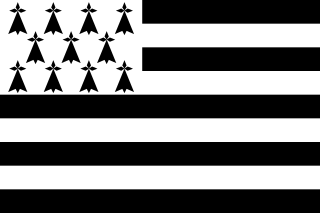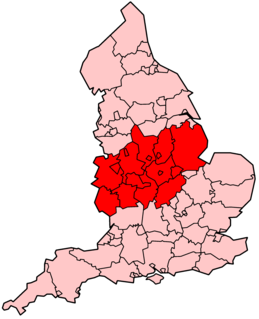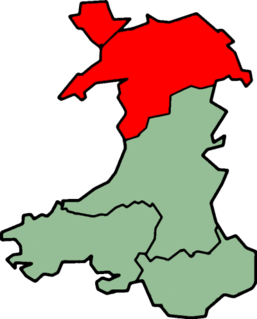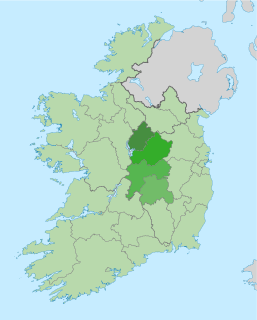
The East Midlands is one of nine official regions of England at the first level of NUTS for statistical purposes. It consists of Derbyshire, Leicestershire, Lincolnshire, Northamptonshire, Nottinghamshire and Rutland. The region has an area of 15,627 km2 (6,034 sq mi), with a population over 4.5 million in 2011. There are five main urban centres, Derby, Leicester, Lincoln, Northampton and Nottingham. Others include Boston, Skegness, Chesterfield, Corby, Grantham, Hinckley, Kettering, Loughborough, Mansfield, Newark-on-Trent and Wellingborough.

Brittany is one of the 18 regions of France. It is named after the historic and geographic region of Brittany, of which it constitutes 80%. The capital is Rennes. Bathed by the English Channel to the north and the Bay of Biscay to the south, it is located in the West of France, bordering the Normandy and Pays de la Loire regions. Bro Gozh ma Zadoù is the anthem of Brittany. It is sung to the same tune as that of the national anthem of Wales, Hen Wlad Fy Nhadau, and has similar words. As a region of France, Brittany has a Regional Council, which was most recently elected in 2015.

The Midlands is an area of central England that borders the South East, South West, North West, East of England and Yorkshire and the Humber. Its largest city is Birmingham. Broadly corresponding to the early medieval Kingdom of Mercia, it was important in the Industrial Revolution of the 18th and 19th centuries. The Midlands are mostly split between the East Midlands and West Midlands.

Strathclyde was one of nine former local government regions of Scotland created by the Local Government (Scotland) Act 1973 and abolished in 1996 by the Local Government etc. (Scotland) Act 1994. The Strathclyde region had 19 districts.

BBC Midlands is the BBC English Region producing local television, radio, web and teletext content for Herefordshire, Shropshire, Staffordshire, Warwickshire, the West Midlands, Worcestershire and small parts of northern Gloucestershire. Although the region has been unofficially called BBC West Midlands since BBC East Midlands became a separate region in 1991, it retains the BBC Midlands name and brand, with its history dating from 1927, for public use.
The regional chambers of England were a group of indirectly elected regional bodies that were created by the provisions of the Regional Development Agencies Act 1998. There were eight regional chambers, one for each of the regions of England except Greater London, which had opted for an elected mayor and assembly in 1998. All eight regional chambers had adopted the title "regional assembly" or "assembly" as part of their name, though this was not an official status in law. The chambers were abolished over a two-year period between 31 March 2008 and 31 March 2010 and some of their functions were assumed by newly established Local authority leaders' boards.

North Wales is a region of Wales. Retail, transport and educational infrastructure are centred on Wrexham, Rhyl, Colwyn Bay, Llandudno and Bangor. It is bordered to the rest of Wales with the counties of Ceredigion and Powys, and to the east by the English counties of Shropshire, Merseyside, and Cheshire.
The National Grid for Learning (NGfL) was a UK government-funded gateway to educational resources on the Internet. It featured many individually selected links to resources and materials deemed to be of high quality. The NGfL was specifically set up to support English schools; separate 'grids' were set up for schools in Northern Ireland, Scotland and Wales.

The economy of Wales is closely linked with the rest of the United Kingdom and the wider European Economic Area. In 2012, according to ONS provisional data, headline gross value added (GVA) in Wales was £47.3 billion, making the Welsh economy the tenth largest of the UK's twelve regions ahead of only Northern Ireland and the North East of England. The modern Welsh economy is dominated by the service sector. In 2000, services contributed 66% to GVA, the manufacturing sector contributed 32%, while agriculture, forestry and fishing together contributed 1.5%.

The Local Government Association (LGA) is an organisation which comprises local authorities in England and Wales. The LGA seeks to promote better local government; it maintains communication between officers in different local authorities to develop best practice. It also represents the interests of local government to national government. 435 authorities are members of the LGA as of 2016, including 349 English councils and the 22 Welsh councils via the Welsh LGA, as well number of smaller authorities including fire authorities and national parks. The Chief Executive is Mark Lloyd.
England is divided into a number of different regional schemes for various purposes. Since the creation of the Government Office Regions in 1994 and their adoption for statistical purposes in 1999, some historical regional schemes have become obsolete. However, many alternative regional designations also exist and continue to be widely used.
BBC English Regions is the division of the BBC responsible for local and regional television, radio, web, and teletext services in England, the Isle of Man, and the Channel Islands. It is one of the BBC's four "nations" – the others being BBC Cymru Wales, BBC Northern Ireland, and BBC Scotland.

BBC East Midlands is the BBC English Region covering Derbyshire, Leicestershire, Nottinghamshire, Rutland, South Kesteven in Lincolnshire and some northern parts of Northamptonshire.

The Midlands Region is a NUTS Level III statistical region of Ireland. It consists of the territory of the counties of Laois, Longford, Offaly and Westmeath. The Midlands region spans 6,524 km2, 9.5% of the total area of the state and according to the 2016 census has a population of 292,301.
The regions of Victoria vary according to the different ways that the Australian state of Victoria is divided into distinct geographic regions. The most commonly-used regions are those created by the state government for the purposes of economic development.

The regions, formerly known as the government office regions, are the highest tier of sub-national division in England. Between 1994 and 2011, nine regions had officially devolved functions within government. While they no longer fulfill this role, they continue to be used for statistical and some administrative purposes. They define areas (constituencies) for the purposes of elections to the European Parliament. Eurostat also uses them to demarcate first level Nomenclature of Territorial Units for Statistics (NUTS) regions within the European Union. The regions generally follow the boundaries of the former standard regions, established in the 1940s for statistical purposes.
The RFU Senior Vase is a rugby union national knockout cup competition in England run by the Rugby Football Union, which has been competed for since the 2006–07 season. It is contested for by teams at level 8 of the English rugby union system, with only 1st XV sides being allowed to enter. The competition is a national one but is split into regions until the semi-finals with the final being held at Twickenham Stadium in London. As of 2018-19 it is the fourth most prestigious national club cup competition in England behind the Premiership Rugby Cup, RFU Championship Cup and RFU Intermediate Cup.
The RFU Junior Vase is a rugby union national knockout cup competition in England run by the Rugby Football Union, which has been competed for since 1990. It is mostly contested by 1st XV teams at level 9 of the English rugby union system, although sides as low as level 12 or even outside the league system can sometimes enter. The competition is a national one, but split into regions until the national semi-finals with the final being held at Twickenham Stadium in London. Presently, the RFU Junior Vase is the fifth most important club cup competition in England, behind the Premiership Rugby Cup, RFU Championship Cup, RFU Intermediate Cup and RFU Senior Vase.
















